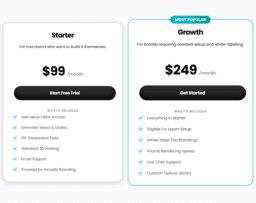Which Reigns Supreme: Daz Studio or Blender?
For entry-level 3D artists desiring convenience and bundled assets, Daz Studio is a superior choice, with its vast library and ease of use. Experienced artists or developers looking for broader functionality and control over their creations may favor the open-source flexibility of Blender.

Key Differences Between Daz Studio and Blender
- Software Type: Daz Studio is a focused 3D model posing and animation tool; Blender is a comprehensive 3D creation suite offering robust features for animation, modeling, and VFX.
- Rendering Engines: Daz Studio uses 3Delight and Iray; Blender uses Eevee renderer after 2.80 release.
- Learning Curve: Daz Studio is quite user-friendly for beginners; Blender, with its extensive capabilities, can have a steep learning curve.
- Cost: Daz Studio is free with purchasable add-ons; Blender is entirely free and open source.
- Unique Features: Daz Studio provides extensive 3D content libraries and Genesis figure customization; Blender offers a versatile platform with broad scripting and development capabilities.
- Application: Daz Studio is predominantly used in character modeling and animation, Blender appeals to a wider range of fields, including game development, films, and visual effects.
| Comparison | Daz Studio | Blender |
|---|---|---|
| Initial Release | 2005 | January 2, 1994 |
| Supported Platforms | Windows Vista and later, Mac OS X 10.6 and later | Linux, macOS, Windows, BSD, Haiku |
| Size | Approx 1.5GB | 193–305 MiB |
| Software Type | 3D computer graphics with freeware professional edition | Free and open-source 3D computer graphics |
| Rendering Engines Supported | 3Delight and Iray | Eevee renderer (Blender Internal removed) |
| Import/Export Formats | Various 3D objects and animations file formats | Alembic, 3DS, FBX, DXF, SVG, STL, UDIM, USD, VRML, WebM, X3D, OBJ |
| Unique Technologies/Features | Genesis figure technology, dForce physics engine | UV mapping, texturing, digital drawing, raster graphics editing, rigging and skinning, fluid and smoke simulation, particle simulation, soft body simulation, sculpting, animation, match moving, rendering, motion graphics, video editing, compositing |
| Commercial Add-Ons | Yes (Daz 3D Marketplace) | No |
| Company Origin | United States | Netherlands |
What Is Daz Studio and Who’s It For?
Daz Studio is a feature-packed 3D design software developed by Daz 3D, first released in 2005. Boasting a freeware professional edition, it supports two rendering engines and is used for posing and manipulating ready-to-use 3D models. The platform is ideal for individuals or businesses in film, TV, animation, video gaming, web design, and print illustrations.
Its unique offerings, like the proprietary Genesis figure technology, and the advent of the dForce physics engine, make it a go-to choice for those seeking lifelike human forms and realistic cloth simulations. With its beginner-friendly user interface as well as advanced capabilities for professionals, the Daz Studio caters to a broad user base. Additionally, through Daz 3D Marketplace, users have access to diverse purchasable 3D content.

Pros of Daz Studio
- User-friendly interface suitable for beginners and professionals
- Genesis figure technology for highly customized human figures
- Extensive content library, free and paid
- dForce physics engine for simulating cloth movement
- Regular updates and backwards compatibility for assets
Cons of Daz Studio
- Large software size (1.5GB approx)
- May require investment in commercial add-on plug-ins
- Comparatively fewer supported platforms
What Is Blender and Who’s It For?
Blender is a robust 3D computer graphics software toolset that’s free and open-source. Originally developed by Dutch animation studio NeoGeo in 1994, it’s used for a wide variety of applications including animated films, visual effects, art, 3D-printed models, interactive 3D applications, and virtual reality. Its diverse features— from texturing to simulation, editing to rendering— make it a powerhouse tool for digital artists.
Primarily developed by the community, with contributions from the Blender Institute team, it’s widely favored by individuals invested in animation, VFX, and 3D-modeling fields. Its open-source nature affords extensive user control and customization, while its multi-platform support guarantees availability for a variety of users.

Pros of Blender
- Free and open-source
- Wide range of features for 3D design
- Multi-platform support
- Strong community involvement
- Multilingual support with availability in 36 languages
Cons of Blender
- Steep learning curve for beginners
- Deprecated Blender Game Engine
- Slow rendering speeds
Daz Studio vs Blender: The Final Verdict
After an in-depth comparison, it’s time to deliver the final verdict. The choice between Daz Studio and Blender largely depends on your specific needs.
Audience One: Beginners
Daz Studio with its ease of use, GUI interface, ready-to-use 3D models, extreme customization, and pre-made animations renders the software a preferred choice for beginners dipping their toes in the world of 3D graphics and animations.

Audience Two: Professional Game Developers
From simulating fluid and smoke, UV Mapping, rigging and skinning, interactive 3D experiences to advanced physics and animations, the open-source nature and extensive features of Blender make it an ideal choice for professional game developers.

Audience Three: AR/VR Creators
Blender steps up to the plate with its support for Virtual Reality and its free, open-source nature allowing extensive modifications. This along with the support of numerous 3D file formats for import/export, makes Blender the best choice for AR/VR creators seeking software adaptability.

Audience Four: Small Business and Budget-Conscious Developers
For those restricted by budget or running small businesses, Daz Studio with its freeware core program and commercial add-on plug-ins makes a compelling case. Its substantive content library and frequent updates and discounts offer a wealth of resources on a smaller budget.

In our Daz Studio vs Blender comparison, while Daz Studio leads with its ease-of-use and curated 3D model-based library making it ideal for beginners and budget-conscious developers, Blender emerges the winner among professional game developers and AR/VR creators with its extensive feature set and open-source approach.







